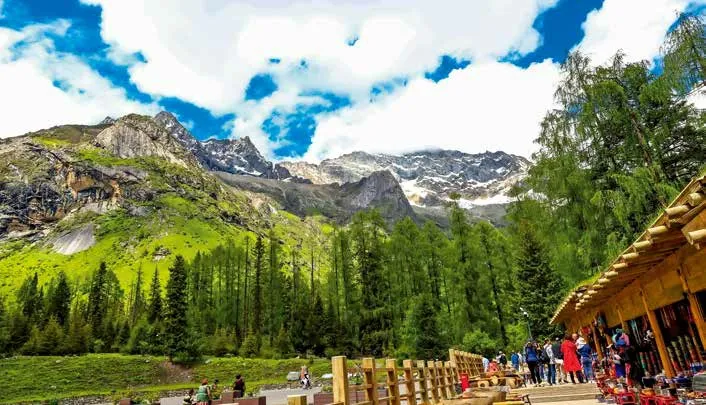双桥沟,那一抹美景
2022-06-14郭晓娟
文、图/郭晓娟

四姑娘山风景名胜区中,双桥沟的自然风景最为集中,也最为迷人。 In the Siguniang Mountain Scenic Area, Shuangqiaogou has the most concentrated and charming natural scenery.
四姑娘山风景名胜区,位于四川省阿坝藏族羌族自治州小金县四姑娘山镇境内,属青藏高原邛崃山脉,距成都220公里。景区由四姑娘山、双桥沟、长坪沟、海子沟组成。
“三沟一山”中,开发最深入、自然风景最为集中也最为迷人、最适合大众旅游的景区当属双桥沟,全长30余公里,面积约216.6平方公里,沟口海拔约2900米,沟尾海拔达到3840米,垂直高度攀升近1000米,包含17个观景点和54个景点。沟内有两座桥,是当地老百姓为了便于通行而搭建,一座由杨柳木搭建而成,俗称“杨柳桥”,另一座由红杉木搭建而成,俗称“便桥”,双桥沟由此得名。
“横看成岭侧成峰,远近高低各不同。”去过双桥沟的人都会发出这样的赞叹。因为沟内两面皆是山,却山山不同,沟内处处皆景,而景景有别,可谓移步换景,一景一韵。这里植物种类丰富,桦木林、柏杨林、青枫林“驻守”在低山地带,云杉、冷杉、红杉却于高山地带倔强生长,还有成片的沙棘、灌木、落叶松交错生长在山间……雄壮奇特的高山与立体分布的植物,在四季变换中构成了一处处迷人的景致,这一抹美景如锦簇画廊,令人流连忘返。
沟内景观分为前段、中段和后段三个景观段。双桥沟的标志——著名的五色山位于前段,与杨柳桥、阴阳谷、白杨林带等将双桥沟点缀得奇特优美;中段为撵鱼坝,人参果坪、沙棘林、尖山子、九架海等山水相融的原始景观让人仿佛置身世外仙境;后段的牛棚子草坪和长河滩,独特奇异的山峰、山石让人不禁感叹大自然的赋予。
双桥沟旅游设施完备又绿色环保,公路贯通整个景区,让游客能够更加方便、快捷、舒适地游览。若想一睹红杉林的芳容,可乘观光车到达沟尾的红杉林冰川,这里因集中分布着成片的红杉而得名。中段以上,一条曲折迂回的木栈桥供游人步行观景,穿梭于森林、溪流间,如在画中行。遇上牧人之家,进去坐一坐,品尝主人准备的鲜奶子、酥油茶,吃一吃喷香的牦牛肉和藏族同胞自制的烧馍馍,疲惫会一扫而光。

猎人峰海拔5360米,由于砂岩风化形成三个大小不同的山尖,如一个矫健的猎人带着猎狗、背着猎枪向山顶进发。The Hunter Peak has an elevation of 5,360 meters, where three pinnacles are formed due to sandstone weathering, like a robust hunter leading a hound, carrying a shotgun, heading for the mountain top.

双桥沟内处处皆景,除了雄伟奇异的山峰外,草甸、牧场等景色亦让人沉醉。In Shuangqiaogou, scenery can be seen everywhere. In addition to majestic and fantastic peaks, such views as meadows and pastureland are also intoxicating.

双桥沟草木相间、云遮雾绕,宛若仙境。Shuangqiaogou is covered with interlaced plants, and shrouded in clouds and mists, like a fairyland.

树木、湖泊和天空构成一个多彩的世界。Trees, lakes and skies constitute a colorful world.

奇秀的风景引得游人流连忘返。Tourists are enchanted by the fantastic scenery, with no thought of leaving.
The Siguniang Mountain Scenic Area, located in Siguniangshan Town, Xiaojin County, Ngawa Tibetan and Qiang Autonomous Prefecture, Sichuan Province, belongs to the Qionglai Mountains on the Tibetan Plateau, and is 220 kilometers from Chengdu. The scenic area consists of the Siguniang Mountain, Shuangqiaogou, Changpinggou, and Haizigou, with the Siguniang Mountain at the center, Haizigou in the east, Changpinggou in the middle, and Shuangqiaogou in the west.
Among the “Three Gullies and One Mountain”, Shuangqiaogou is the most deeply developed attraction, perfect for mass tourism, with the most concentrated and charming natural scenery. With an overall length of more than 30 kilometers and an area of 216.6 square kilometers, it contains 17 lookouts and 54 scenic spots. In the gully, there are two bridges, which were built by the local people for ease of passage. One, built of willow, is commonly known as the Willow Bridge; the other, built of redwood, is commonly known as the Bian Bridge. Thus, it got the name Shuangqiaogou (Twin Bridge Gully).
The landscape therein is divided into three landscape sections, respectively, the front, middle and rear section. The symbol of Shuangqiaogou—famous Wuse Mountain, is located in the front section, which fantastically and finely embellishes Shuangqiaogou, together with the Willow Bridge, the Yin-Yang Valley, the Poplar Woods, etc.; the middle section is Nianyuba, where the original landscape integrating waters and mountains, including the Ginseng Fruit Lawn, the Seabuckthorn Woods, Jianshanzi, and Jiujiahai, seems to expose vis-itors into an earthly paradise; the rear section includes the Niupengzi Lawn and Changhetan, where fantastic peaks and stones make visitors marvel at the gifts of nature.
Shuangqiaogou has complete tourist facilities, and is green and environment-friendly. With a highway running through the scenic area, it enables tourists to enjoy a more convenient, comfortable, and faster tour. If you want to see the redwood forest, you may take a sightseeing vehicle to the Redwood Forest Glacier at the tail of the gully, which got the name because of the large areas of intensively distributed redwoods. Above the middle section, there is a winding wooden trestle for visitors to view scenery on foot. Walking through the forest and the ravine stream, you may feel like rambling in a painting.
